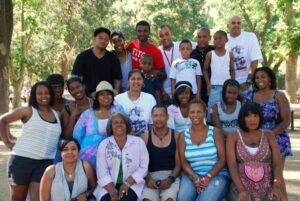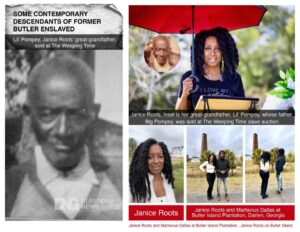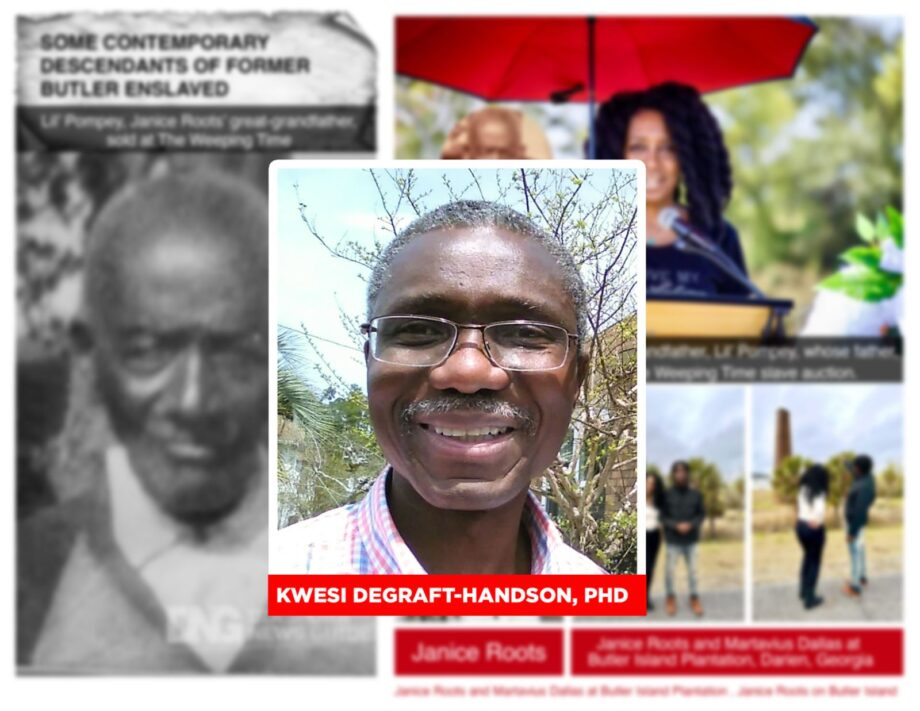After 26 years and still doing what he started in 1998, Kwesi DeGraft-Hanson, Ph.D., is on a mission to find the missing piece that connects Africa and the African Diasporas.
“What connects us to our heritage are our great-grandfathers and great-grandmothers, and without them, there is no ‘us’,” Kwesi said.
In 1983, when we drove past Butler Island in coastal Georgia, in the USA, there was not a single indication to show that our great-grandparents had toiled there, contributed invaluable construction and agricultural knowledge there, and had been sold from there.
It was a chilling realization years later, in 1998, to learn that Pierce Mease Butler (1810-1867) and his brother’s widow, Gabriella Butler, had owned a rice plantation on Butler Island, near Darien, and a nearby cotton plantation, Hampton, which were worked by 919 enslaved Africans and African Americans.
These enslaved had brought with them African engineering skills that enabled them to establish the complex dams, reservoirs, and drainage needed to plant, cultivate, and harvest the rice and cotton fields. They fabricated their work tools; they were bricklayers, tailors, shoemakers, milliners, chefs, and caretakers. They also brought, and kept, some African (including Ghanaian) names.
In February 1859, Butler, in debt from gambling, had the 919 enslaved persons appraised; their value was placed (then) at around US $500,000.

In 1998, DeGraft-Hanson began collaborating with friends and acquaintances in Georgia to bridge the missing piece that connects Africa and the Africa Diaspora to their heritage and to commemorate our ancestral great-grandparents who paved the way for us.
Today, the alliance has connected with and involved people from various states in addition to Georgia—including from Florida, California, Pennsylvania, Tennessee, New Jersey, and Alabama. Most recently, and in a “coming full circle” moment, Ghanaians and African Americans in Ghana have embraced this project. Today also, the team, The Weeping Time Commemoration Committee, consists of resolute professionals volunteering their time, knowledge, and resources to advance this mission.
The project: The Weeping Time
In 1859, on March 2 and 3, a large sale of enslaved persons happened in Savannah, Georgia. It was one of the single largest human auctions in recorded U.S. history. Pierce M. Butler, to satisfy his creditors, had almost half of the 919 enslaved people on his plantations brought to Savannah and sold, for $303,800 (over ten million dollars today).
Rain fell torrentially during the two days of the auction, letting up only after the last person had been sold. The enslaved surmised that God was weeping during the sale, hence the name The Weeping Time. According to Mortimer Thomson, an eyewitness journalist who observed and wrote about the event, all the enslaved grieved, but “none wept.” The 429 men, women, and children put up for sale were consequently dispersed throughout the American South. The sale had been advertised not only in Georgia’s cities but also in Charleston, Mobile, Memphis, Vicksburg, Richmond, and New Orleans.
Weeping Time Project: Connecting the missing piece.
Despite centuries of forced labor and contributions to the development of the United States, Africans and their African American descendants who were enslaved in America do not currently have a specific major national slavery monument honoring them and their sacrifices.
We are advocating for a national slavery memorial to be built in America, and with a concomitant part in Africa, to connect the Africa Diaspora to our ancestors. The memorials also seek to foster collective understanding and reconciliation among descendants of those who were enslaved and descendants of the enslavers and enablers.

“I believe that through awareness creation, education, and the art of the memorial, we will be able to come together as one people with a fixed identity.” Kwesi stated.
Successes: Through research, seminars, awareness creation, and serendipity, we have been able to trace some contemporary descendants of former Butler enslaved. In 2011, the Savannah chapter of Alpha Kappa Alpha sorority invited me to speak about the Weeping Time at Savannah’s Beach Institute.
Anticipating questions about where the enslaved persons ended up, I began a search that took me to a website listing some of the Butler enslaved persons who had been sold. The author of the site was Annette Holmes, of California, a great-great granddaughter descendant of John and Betsey, a couple sold at The Weeping Time. Annette has been working to discover and connect as many descendants as possible of those formerly enslaved on the Butler plantations.

Shortly after 2011, we connected with Carmen Butler, of Philadelphia, also a descendant from the former Butler plantations. Her father, born in Philadelphia, had told her that his father told him that they were from Georgia. Carmen has been coming to the annual Weeping Time Commemoration events regularly. In addition to her speaking at our events, Carmen, a professional artistic dancer, shares her talents with our audiences.

In 2023, and in 2024, Ms. Janice Roots, from New Jersey, who had discovered she is a direct descendant of at least five people sold at The Weeping Time, came down to Savannah, Darien, and Butler Island to join anniversary commemorations for The Weeping Time.
She has brought amazing energy, knowledge, and insight into this project. An advocate of the importance of DNA, she encouraged Kwesi (among others) to do his DNA. It turns out he is connected by DNA to Janice, and other descendants of those formerly enslaved on the Butler plantations.

You can be part of this, “The Weeping Time Project,” to help bridge the gaps—connecting families, connecting communities, connecting continents—as we garner support for the design, creation, and management of a major national memorial to commemorate all those Africans and their American descendants who were enslaved in the United States of America. We need oneness, support, teamwork, resources, and love to reach our vision.
It is time we connect to our roots, remember, honor, and invoke the spirits of our forebears whose toils have made us who we are today, and made America what it is. Connect with us at www.oceans1.org and at https://www.facebook.com/TheWeepingTime.

14’ Smoke-grey Glass Wall; Reflective & Transparent; Reflection Pools; Scrolling LCD Names; 7 Palms, clusters; 7’ diameter Tabby (a concrete) columns; and a ½ Acre Water-rilled Site.
About Kwesi DeGraft-Hanson
Kwesi J. DeGraft-Hanson, Ph.D. (Emory University), is a landscape architect in Atlanta who also specializes in reclaiming and preserving the sites of historic landmarks and landscapes like the Ten Broeck Racecourse, where the 1859 Weeping Time Slave Sale took place.
A Ghanaian born in the U.K., DeGraft-Hanson grew up in Ghana and did graduate studies in the US, where he has lived for 41 years. His personal geographies echo the trans-Atlantic Slave trade routes, and that peculiarity inspires him to help commemorate the former enslaved people.
The End!
Story by: Ishmael Awudi




